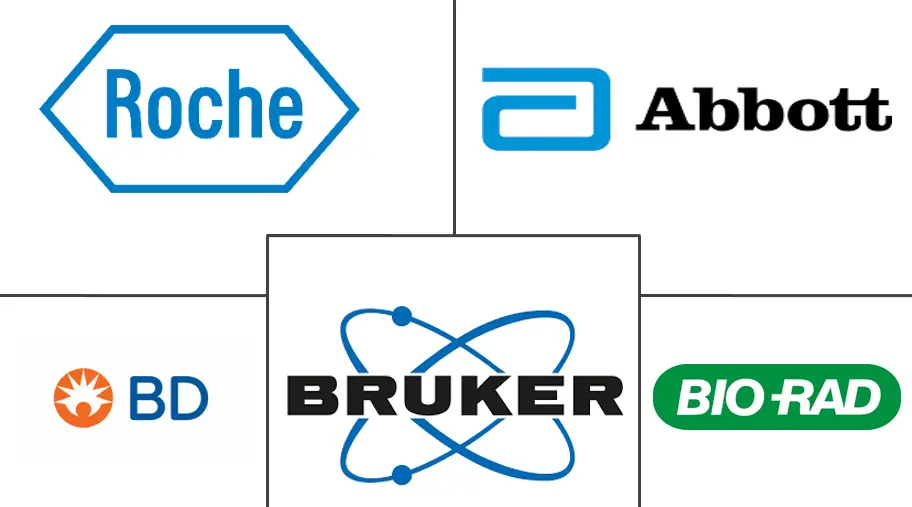Microbiology Testing Market Size and Share
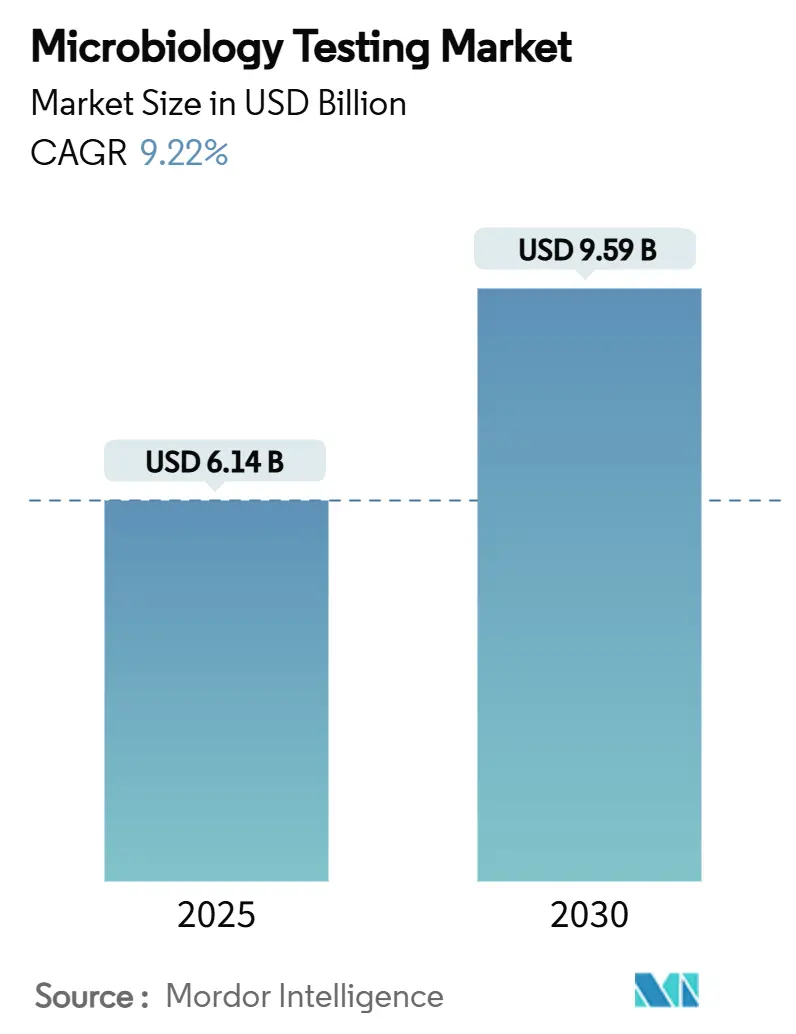
Microbiology Testing Market Analysis by Mordor Intelligence
The microbiology testing market size reached USD 6.14 billion in 2025 and is forecast to register a CAGR of 9.22%, lifting revenue to USD 9.59 billion by 2030. Clinical demand for faster pathogen identification, the spread of antimicrobial resistance, and accelerating laboratory automation are the strongest growth catalysts. Governments have tightened regulatory oversight of pharmaceutical, food, and personal-care supply chains, which raises the frequency and scope of routine microbial quality control. At the same time, AI-enabled mass-spectrometry and molecular platforms shorten turnaround times, allowing hospitals to start targeted therapy within hours instead of days. Laboratories facing double-digit vacancy rates view total laboratory automation as the most practical remedy for chronic staffing shortages. Manufacturers that can combine rapid diagnostics with connectivity, analytics, and remote-support features will capture a disproportionate share of future tenders in the microbiology testing market.
Key Report Takeaways
- By application, clinical diagnostics held 31.34% of microbiology testing market share in 2024; cosmetic testing is projected to expand at an 11.45% CAGR through 2030.
- By product, reagents and consumables accounted for 73.56% of the microbiology testing market size in 2024, while instruments and equipment are advancing at an 11.89% CAGR to 2030.
- By technology, culture-based methods retained 46.53% revenue share in 2024; molecular diagnostics are forecast to grow at a 12.45% CAGR between 2025 and 2030.
- By end user, hospitals and diagnostic laboratories commanded 52.65% of the microbiology testing market in 2024, whereas academic and research institutes show the fastest CAGR of 12.77% through 2030.
- By geography, North America led with 42.43% revenue share in 2024; Asia-Pacific is poised for a 10.54% CAGR during the outlook period.
Global Microbiology Testing Market Trends and Insights
Driver Impact Analysis
| Driver | % Impact on CAGR Forecast | Geographic Relevance | Impact Timeline |
|---|---|---|---|
| Advancements in diagnostic technologies and automation | +2.1% | Global; early uptake in North America and EU | Medium term (2-4 years) |
| Growing incidence of infectious diseases and antimicrobial resistance | +1.8% | Global; particularly acute in APAC and other emerging markets | Long term (≥ 4 years) |
| Expansion of public and private healthcare funding | +1.4% | APAC core; spill-over to MEA and Latin America | Medium term (2-4 years) |
| Rising demand for rapid and point-of-care testing solutions | +1.6% | Global; strong demand in North America and EU | Short term (≤ 2 years) |
| Stringent regulatory standards for product safety and quality | +1.2% | North America and EU; expanding to APAC | Long term (≥ 4 years) |
| Diversifying applications in pharmaceutical, food, and environmental testing | +1.1% | Global; concentrated in developed markets | Medium term (2-4 years) |
| Source: Mordor Intelligence | |||
Advancements in Diagnostic Technologies and Automation
Laboratory automation reshapes microbiology workflows by pairing robotics with AI-guided imaging systems that cut plating and reading times by around 40%, a clear benefit when vacancy rates in clinical labs hover near 25%. Mass-spectrometry platforms such as MALDI-TOF now integrate machine-learning models capable of species-level identification in minutes, replacing manual techniques that once required up to two days[1]Nature Scientific Data, “Machine Learning-Assisted MALDI-TOF for Bacterial Identification,” nature.com. Fully automated “dark labs” operate lights-out shifts to keep essential testing running during staffing shortages or crises like COVID-19. Interoperability with hospital information systems enables seamless data flow that supports infection-control dashboards and antimicrobial-stewardship alerts. Vendors that bundle hardware, reagents, and cloud-based analytics under service contracts improve uptime while lowering ownership costs, enhancing the attractiveness of their offers in the microbiology testing market.
Growing Incidence of Infectious Diseases and Antimicrobial Resistance
Rising drug-resistant pathogens push clinicians to adopt culture-independent tests that can deliver identification and resistance markers inside the first critical hours of patient admission. Healthcare-associated infections in the United States alone cost more than USD 20 billion annually, intensifying pressure on hospitals to deploy rapid diagnostics that prevent broad-spectrum antibiotic overuse. Climate-driven expansion of mosquito-borne diseases increases the baseline demand for molecular panels that can differentiate co-circulating arboviruses. Evidence that targeted therapy lowers mortality and length of stay amplifies interest in one-hour multiplex PCR assays. Policy makers channel funding toward surveillance networks that rely on timely microbiology data, which in turn enlarges the installed base of advanced systems across the microbiology testing market.
Expansion of Public and Private Healthcare Funding
National preparedness plans created after COVID-19 include dedicated budgets for laboratory modernization, sharply raising capital spending in Asia-Pacific. Public-private partnerships subsidize installation of total laboratory automation in secondary and tertiary hospitals, while global aid programs finance training for molecular technicians. Private insurers increasingly reimburse point-of-care microbiology tests because early pathogen confirmation curbs unnecessary hospital admissions. Pharmaceutical manufacturers allocate a larger portion of plant expansion budgets to environmental monitoring suites that comply with evolving Good Manufacturing Practice guidelines. Collectively, these financial flows expand the addressable pool of end users for the microbiology testing market.
Rising Demand for Rapid and Point-of-Care Testing Solutions
Clinicians value assays that shrink result times from 48 hours to less than 30 minutes, enabling immediate triage decisions in emergency units. Microfluidic cartridges integrate extraction, amplification, and detection in palm-sized devices powered through smartphones, supporting telemedicine follow-up for rural patients[2]Frontiers in Bioengineering and Biotechnology, “Smartphone-Linked Microfluidic Diagnostics,” frontiersin.org. Success of decentralized COVID-19 testing validated the economic case for portable diagnostics and has accelerated product pipelines aimed at respiratory, enteric, and sepsis pathogens. AI-driven readers now guide non-specialist staff through test interpretation, minimizing errors. As a result, hospitals, urgent-care chains, and even retail clinics represent fresh customer segments within the microbiology testing market.
Restraints Impact Analysis
| Restraints Impact Analysis | (~) % Impact on CAGR Forecast | Geographic Relevance | Impact Timeline |
|---|---|---|---|
| High capital investment and operational costs | -1.7% | Global; particularly acute in emerging markets | Medium term (2-4 years) |
| Reimbursement and pricing challenges for novel tests | -0.9% | North America and EU; expanding elsewhere | Long term (≥ 4 years) |
| Shortage of skilled laboratory personnel | -1.2% | Global; most severe in developed markets | Short term (≤ 2 years) |
| Supply-chain disruptions for critical reagents and consumables | -0.8% | Global; with regional variations | Short term (≤ 2 years) |
| Source: Mordor Intelligence | |||
High Capital Investment and Operational Costs
Total laboratory automation systems require upfront outlays of USD 2-5 million per site, a hurdle that smaller community hospitals and independent labs struggle to clear. MALDI-TOF instruments cut per-test costs but still demand more than USD 500,000 for hardware plus annual database licensing fees. Molecular reagent packs priced at USD 100-200 per panel dwarf the USD 10-20 consumable spend of culture methods, limiting routine use in low-volume settings. Facilities must also budget for controlled-environment rooms, redundant power, and specialized IT infrastructure. Without volume-based discounts, many emerging-market labs remain locked out of next-generation platforms, constraining the reachable segment of the microbiology testing market.
Shortage of Skilled Laboratory Personnel
Vacancy rates exceeding 25% in critical roles mean remaining technologists handle higher workloads, a situation that 95% of professionals say jeopardizes diagnostic accuracy. Molecular tests demand expertise in nucleic-acid extraction, thermal-cycling protocols, and post-analytic bioinformatics, skills not widely taught in standard clinical-lab curricula. Retirement of senior microbiologists outpaces new graduate output, especially in Europe and the United States. Competitive pay in biotech and pharma diverts talent away from routine diagnostics. Even high-automation sites still need trained staff to validate instrument flags and manage quality systems, making workforce limitations a persistent drag on growth for the microbiology testing market.
Segment Analysis
By Application: Clinical Diagnostics Dominates Amid Cosmetic Testing Surge
Clinical diagnostics delivered 31.34% of 2024 revenue, reflecting hospitals’ priority to curtail healthcare-associated infections with same-day pathogen confirmation. Pharmaceutical-quality control ranked second in value because cGMP rules obligate batch release only after sterile assurance testing. Food and beverage processors adopted Hazard Analysis and Critical Control Point standards that mandate pathogen screening at multiple checkpoints. Environmental monitoring tract steadily due to stricter wastewater and remediation rules.
Cosmetic testing posts the quickest expansion at an 11.45% CAGR as EU Regulation 1223/2009 compels safety dossiers, and the shift toward preservative-light “clean label” formulas raises contamination risk. As brands promote plant-based ingredients, microbial hurdles climb, driving demand for challenge testing and preservative-efficacy studies. Contract labs specializing in personal-care microbiology capture new outsourcing contracts, enlarging their footprint within the microbiology testing market size.
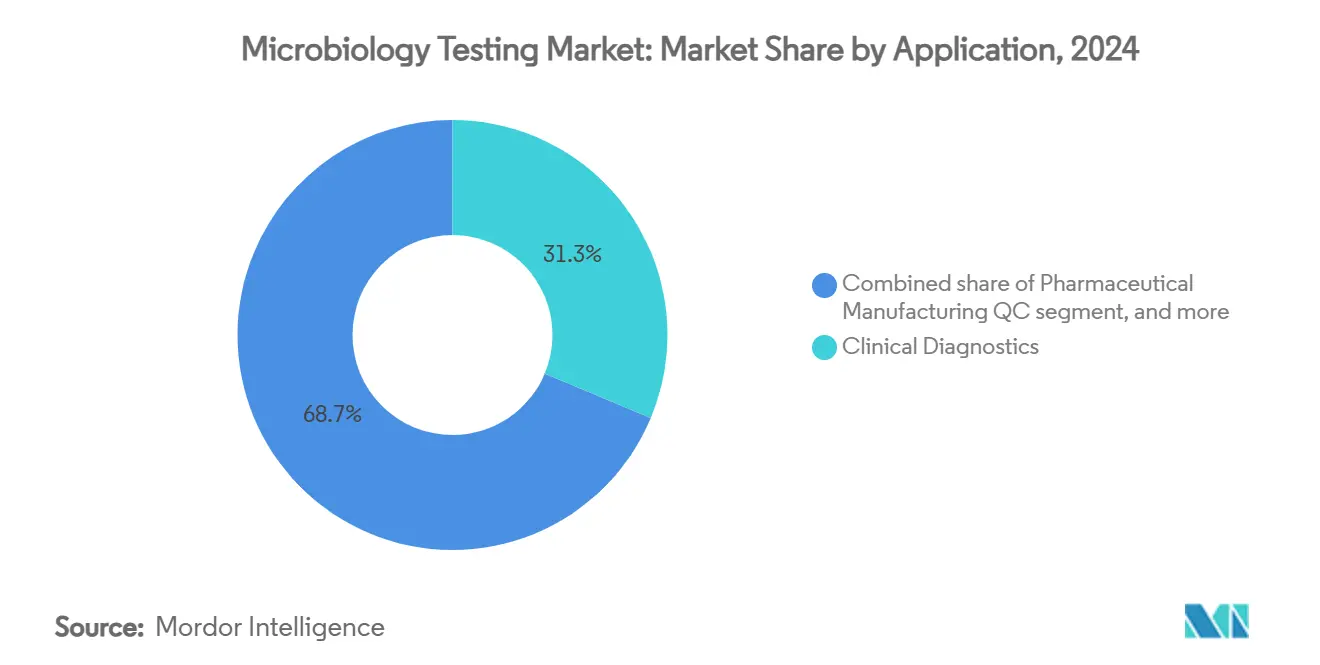
Note: Segment shares of all individual segments available upon report purchase
By Product: Reagents Lead While Instruments Accelerate
Reagents and consumables controlled 73.56% of 2024 spending because every culture or molecular run consumes media, panels, discs, or cartridges, ensuring steady replenishment cycles. Stock-out scares during the COVID-19 crisis convinced procurement teams to diversify suppliers and build inventory buffers. Multi-plex respiratory panels, chromogenic media, and AST cards remain staple revenue generators, anchoring the cash-flow base for manufacturers in the microbiology testing market.
Instrumentation revenue rises at an 11.89% CAGR as laboratories upgrade to high-throughput streakers, incubators, and mass-spectrometry analyzers that compress workflow times. More than 550 VITEK MS PRIME systems were installed in 2024 alone, reflecting demand for faster identification without sacrificing accuracy. Automated susceptibility platforms that pair with LIS middleware unlock real-time reporting and antimicrobial-stewardship notifications. Service contracts and software licenses add an annuity layer to hardware sales, enhancing lifetime customer value.
By Technology: Molecular Diagnostics Disrupt Culture-Based Dominance
Culture methods still accounted for 46.53% of 2024 revenue because regulators insist on phenotypic antimicrobial-susceptibility results before approving therapy changes in complex infections. Automated broth micro-dilution and imaging shorten incubation cycles, yet two-day turnaround remains common. Some pathogens, notably anaerobes and slow-growing mycobacteria, cannot yet be fully resolved by molecular shortcuts, preserving the role of culture in the microbiology testing market.
Molecular diagnostics grow at a 12.45% CAGR, propelled by hospital stewardship protocols that demand pathogen identification inside stewardship-critical windows. PCR and isothermal amplification panels detect multiple targets in one cartridge, easing sample-handling burden. Syndromic panels adopted in emergency departments cut empirical broad-spectrum antibiotic use, aligning practice with resistance-mitigation goals. As a result, molecular platforms absorb incremental budget share without fully displacing traditional culture, enlarging total microbiology testing market size.
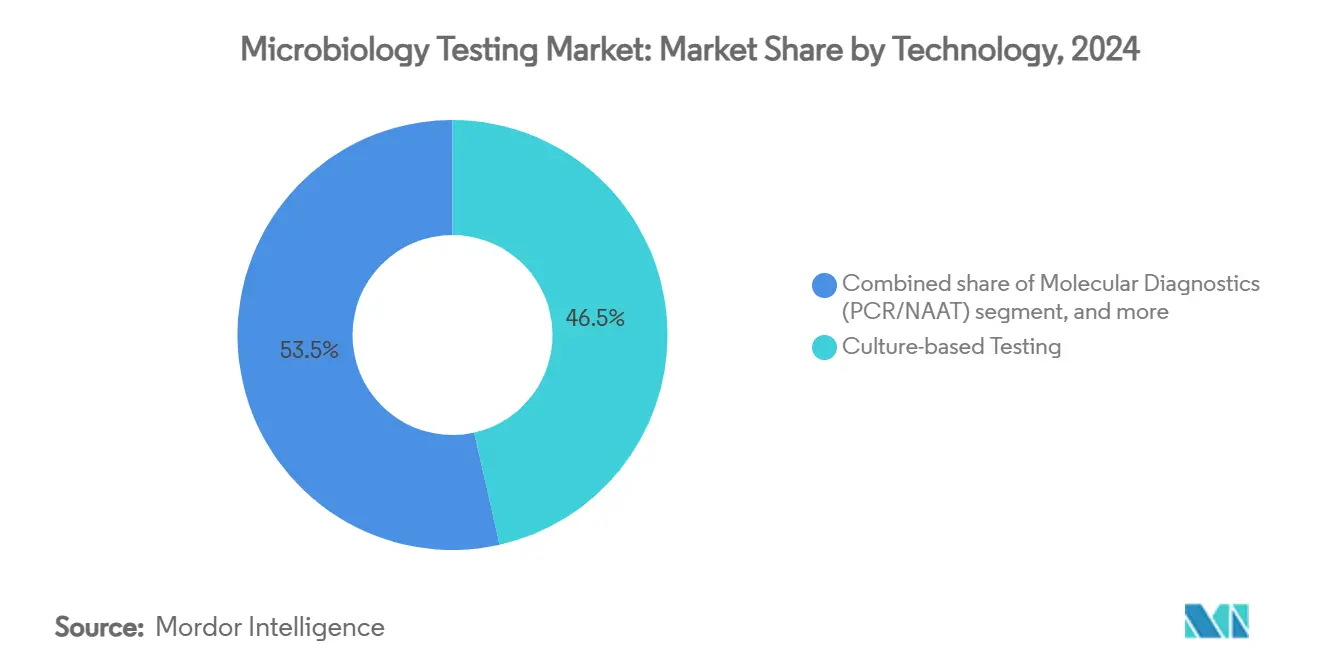
Note: Segment shares of all individual segments available upon report purchase
By End User: Hospitals Dominate as Academic Institutes Accelerate
Hospitals and diagnostic laboratories collected 52.65% of global revenue in 2024 because acute-care physicians rely on near-real-time microbiology to guide therapy decisions. Centralized networks route samples from multiple collection sites to automated hubs that operate 24/7, maximizing asset utilization. Volumes are large enough to justify capital investment in mass-spectrometry and total laboratory automation, reinforcing hospital dominance in the microbiology testing market.
Academic and research institutes expand at a 12.77% CAGR, buoyed by national bio-preparedness programs funneling grants toward pathogen-discovery and vaccine-development projects. Funding covers specialized instruments such as high-resolution sequencing and metagenomic classifiers. Pharmaceutical and biotech firms retain steady demand for in-process control and release testing, while food and contract labs broaden service menus to win multi-year outsourcing contracts.
Geography Analysis
North America generated 42.43% of 2024 revenue, underpinned by advanced hospital infrastructure, mandatory infection-control guidelines, and a clear regulatory pathway for novel diagnostics[3]U.S. Food and Drug Administration, “Guidance for Industry: Microbiological Testing of Diagnostics,” fda.gov. The Food Safety Modernization Act obliges extensive pathogen monitoring, stimulating demand from food processors and reference labs. Federal programs that reimburse rapid diagnostics strengthen the business case for premium molecular panels, reinforcing leadership of the microbiology testing market in the region.
Europe ranks second and upholds stringent standards under Regulation 2073/2005 for foodstuffs and the well-enforced cGMP framework for pharmaceuticals. Germany, France, and the Nordics account for the bulk of installed automation lines, and Regulation 1223/2009 keeps cosmetic-testing laboratories busy across the bloc. Collaborative surveillance through the European Centre for Disease Prevention and Control harmonizes outbreak response, indirectly encouraging pan-regional adoption of advanced testing systems.
Asia-Pacific is the fastest-growing territory with a 10.54% CAGR as China, India, and Southeast Asian countries pour capital into laboratory networks that underpin public-health resilience. Massive expansions in biologics and vaccine manufacturing create steady need for environmental monitoring and sterility testing. Japanese hospitals, early adopters of point-of-care molecular devices, showcase the operational gains of rapid diagnostics, prompting regional peer institutions to follow suit. As infrastructure improves, previously underserved rural markets open, enlarging the total addressable microbiology testing market size across the region.
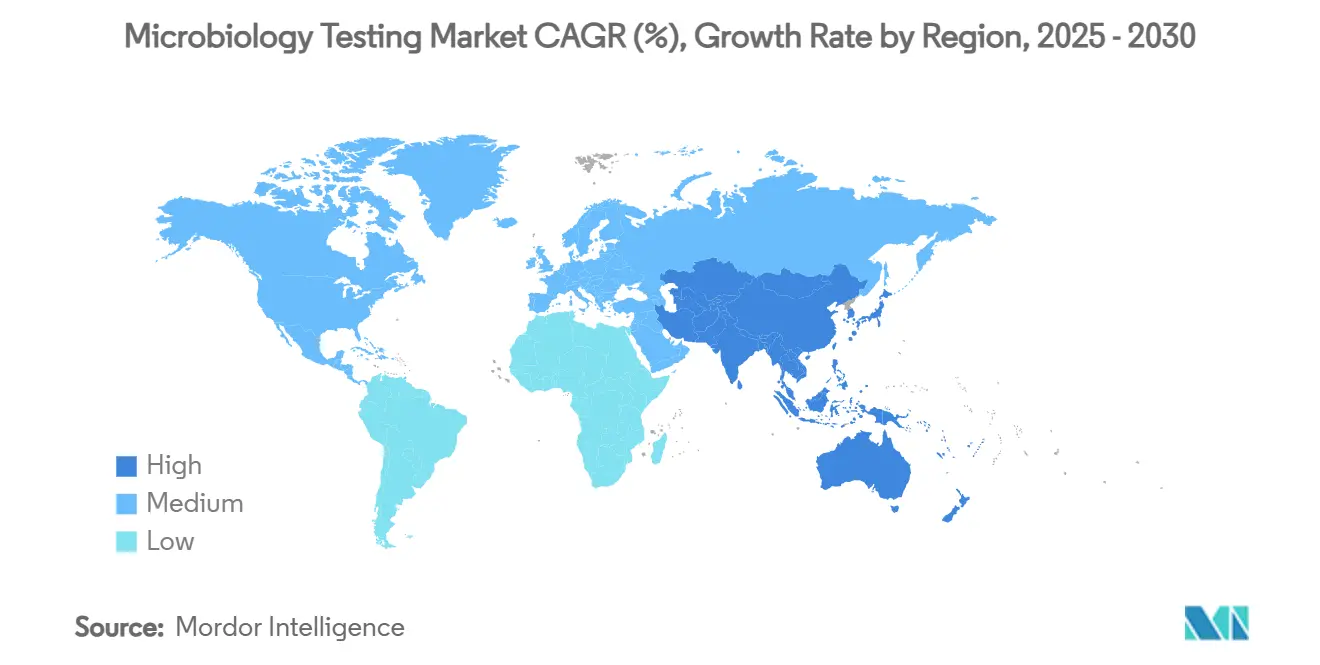
Competitive Landscape
The microbiology testing industry is moderately fragmented, yet scale advantages favor corporations that supply integrated platforms spanning clinical, industrial, and environmental applications. bioMérieux led 2024 growth with 8.7% sales expansion, underpinned by the rollout of VITEK MS PRIME and the acquisition of SpinChip Diagnostics, which adds 10-minute immunoassay capability. Thermo Fisher Scientific reinforced vertical-integration synergy by launching contract development and manufacturing offerings that tie test kits to bioprocess equipment. Abbott leveraged epidemiological research to tailor rapid panels toward mosquito-borne pathogens that clinicians expect to rise under climate-change scenarios.
Strategic acquisitions accelerate footprint broadening. Mérieux NutriSciences paid USD 393.4 million to absorb Bureau Veritas’ food-testing arm, instantly adding 34 laboratories and doubling exposure in Canada and Asia-Pacific. BD introduced MiniDraw, a capillary collection system that eliminates phlebotomy in many point-of-care workflows, expanding its reach beyond core laboratory instrumentation [BD.COM]. Emerging firms such as BugSeq, backed by BARDA, marry cloud-based AI with metagenomic sequencing to deliver pathogen-agnostic reports suitable for hard-to-diagnose infections.
Partnerships catalyze technology diffusion. bioMérieux and Illumina co-develop next-generation sequencing kits standardized on MiSeq instruments, combining 80,000-strain reference libraries with routine lab workflows. Equipment makers collaborate with LIS vendors to embed rule-based reporting that automates antimicrobial-stewardship alerts. Service-level agreements now include remote monitoring, predictive maintenance, and reagent auto-replenishment, enhancing customer retention within the microbiology testing market.
Microbiology Testing Industry Leaders
-
Bio-Rad Laboratories Inc.
-
Abbott Laboratories
-
Bruker Corporation
-
Becton Dickinson and Company
-
F. Hoffmann-La Roche Ltd
- *Disclaimer: Major Players sorted in no particular order
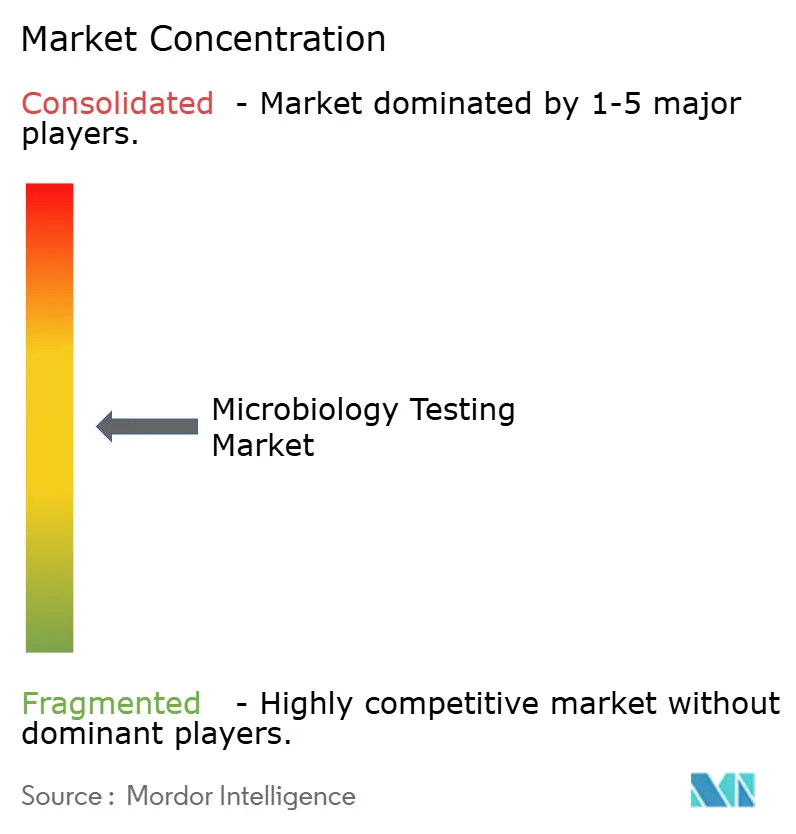
Recent Industry Developments
- March 2025: Becton Dickinson launched BD MiniDraw capillary blood-collection technology with laboratory-equivalent accuracy using fingertip samples.
- February 2025: bioMérieux acquired SpinChip Diagnostics, adding a 10-minute whole-blood immunoassay platform aimed at cardiac markers.
- January 2025: Abbott published a global epidemiologist survey warning that viral and mosquito-borne pathogens will dominate future outbreaks.
- October 2024: Mérieux NutriSciences completed the USD 393.4 million purchase of Bureau Veritas’ food-testing business, adding 34 laboratories.
- October 2024: Thermo Fisher Scientific introduced CDMO and CRO services at CPHI Milan to extend its pharmaceutical value-chain reach.
- July 2024: BugSeq won a second BARDA DRIVe award to refine AI-powered clinical-metagenomics reporting.
Global Microbiology Testing Market Report Scope
As per the scope of the report, microbial testing is an analytical technique that is utilized to determine the number of microorganisms in food, beverages, biological samples, and environmental samples. The microbial testing technique employs chemical, biological, biochemical, or molecular methods to identify and quantify the microbes. It is one of the important processes carried out in the medical, healthcare, and food industries for the prevention of future product damage. The Microbiology Testing Market is segmented by Application (Pharmaceutical Application, Diagnostic Application, Food and Beverage Testing Application, Environmental Application, Cosmetic Application, Other Applications), Product (Equipment and Reagents), and Geography (North America, Europe, Asia-Pacific, Middle East and Africa, and South America). The market report also covers the estimated market sizes and trends for 17 different countries across major regions globally. The report offers the value (in USD million) for the above segments.
| Clinical Diagnostics |
| Pharmaceutical Manufacturing QC |
| Food & Beverage Testing |
| Environmental Monitoring |
| Cosmetic Testing |
| Industrial Quality Control |
| Instruments & Equipment |
| Reagents & Consumables |
| Software & Services |
| Culture-based Testing |
| Molecular Diagnostics (PCR/NAAT) |
| Mass Spectrometry (MALDI-TOF) |
| Rapid/Automated Methods |
| Biosensors & Nano-based Assays |
| Hospitals & Diagnostic Laboratories |
| Pharmaceutical & Biotech Companies |
| Food & Beverage Companies |
| CROs & CMOs |
| Academic & Research Institutes |
| Environmental Testing Labs |
| Cosmetics & Personal-Care Labs |
| North America | United States |
| Canada | |
| Mexico | |
| Europe | Germany |
| United Kingdom | |
| France | |
| Italy | |
| Spain | |
| Rest of Europe | |
| Asia-Pacific | China |
| Japan | |
| India | |
| Australia | |
| South Korea | |
| Rest of Asia-Pacific | |
| Middle East & Africa | GCC |
| South Africa | |
| Rest of Middle East & Africa | |
| South America | Brazil |
| Argentina | |
| Rest of South America |
| By Application | Clinical Diagnostics | |
| Pharmaceutical Manufacturing QC | ||
| Food & Beverage Testing | ||
| Environmental Monitoring | ||
| Cosmetic Testing | ||
| Industrial Quality Control | ||
| By Product | Instruments & Equipment | |
| Reagents & Consumables | ||
| Software & Services | ||
| By Technology | Culture-based Testing | |
| Molecular Diagnostics (PCR/NAAT) | ||
| Mass Spectrometry (MALDI-TOF) | ||
| Rapid/Automated Methods | ||
| Biosensors & Nano-based Assays | ||
| By End User | Hospitals & Diagnostic Laboratories | |
| Pharmaceutical & Biotech Companies | ||
| Food & Beverage Companies | ||
| CROs & CMOs | ||
| Academic & Research Institutes | ||
| Environmental Testing Labs | ||
| Cosmetics & Personal-Care Labs | ||
| Geography | North America | United States |
| Canada | ||
| Mexico | ||
| Europe | Germany | |
| United Kingdom | ||
| France | ||
| Italy | ||
| Spain | ||
| Rest of Europe | ||
| Asia-Pacific | China | |
| Japan | ||
| India | ||
| Australia | ||
| South Korea | ||
| Rest of Asia-Pacific | ||
| Middle East & Africa | GCC | |
| South Africa | ||
| Rest of Middle East & Africa | ||
| South America | Brazil | |
| Argentina | ||
| Rest of South America | ||
Key Questions Answered in the Report
What is the current size of the microbiology testing market?
The microbiology testing market size stood at USD 6.14 billion in 2025 and is projected to reach USD 9.59 billion by 2030.
Which application segment generates the highest revenue?
Clinical diagnostics leads with 31.34% of revenue in 2024, primarily due to hospital demand for rapid pathogen identification.
What technology is growing fastest in microbiology testing?
Molecular diagnostics, including PCR and nucleic-acid amplification, are advancing at a 12.45% CAGR through 2030.
Why is Asia-Pacific considered the most attractive growth region?
Healthcare infrastructure upgrades, pharmaceutical manufacturing expansion, and rising food-safety awareness underpin a 10.54% CAGR in Asia-Pacific.
How are staffing shortages influencing laboratory investment decisions?
Vacancy rates near 25% push laboratories to invest in total automation systems that cut manual workload and maintain turnaround times.
Which companies are strengthening their competitive position through acquisitions?
BioMérieux, Mérieux NutriSciences, and Thermo Fisher Scientific have all closed strategic deals to broaden technology portfolios and geographic reach.
Page last updated on:
